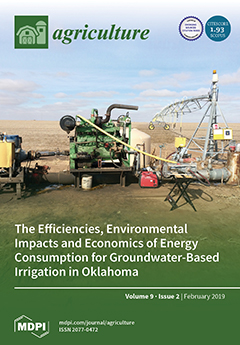Green manure application helps maintain soil fertility, reduce chemical fertilizer use, and carbon sequestration in the soil. Nevertheless, the application of organic matter in paddy fields induces CH
4 and N
2O emissions. Prolonging mid-season drainage reduces CH
4 emissions in paddy
[...] Read more.
Green manure application helps maintain soil fertility, reduce chemical fertilizer use, and carbon sequestration in the soil. Nevertheless, the application of organic matter in paddy fields induces CH
4 and N
2O emissions. Prolonging mid-season drainage reduces CH
4 emissions in paddy fields. Therefore, the combined effects of green manure application and mid-season drainage prolongation on net greenhouse gas emission (NGHGE) were investigated. Four experimental treatments were set up over a 2-year period: conventional mid-season drainage with (CMG) and without (CM) green manure and prolonged (4 or 7 days) mid-season drainage with (PMG) and without (PM) green manure.
Astragalus sinicus L. seeds were sown in autumn and incorporated before rice cultivation. No significant difference in annual CH
4 and N
2O emissions, heterotrophic respiration, and NGHGE between treatments were observed, indicating that green manure application and mid-season drainage prolongation did not influence NGHGE. CH
4 flux decreased drastically in PM and PMG during mid-season drainage under the hot and dry weather conditions. However, increasing applied carbon increases NGHGE because of increased CH
4 and Rh. Consequently, combination practice of mid-season drainage prolongation and green manure utilization can be acceptable without changing NGHGE while maintaining grain yield in rice paddy fields under organically managed rice paddy fields.
Full article





